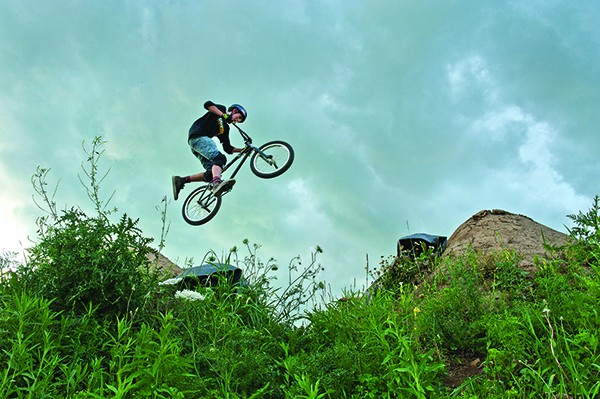Outside a stone house in Hurley, between the front door and the driveway, the snow was packed hard into a jump. Fifteen-year-old Ever Peacock came in fast, hit the jump, and kicked the BMX bike out from under him in mid-air so it spun a circle beneath him, before he reseated for the landing. Afterward, his face completely changed. Peacock's quiet reserve turned into an ear-to-ear grin. "That was a tail whip," he says.
At first glance, BMX might seem dangerous. But like any sport, there's more to it. With homegrown, kid-derived roots, BMX is marked by innovation. In the late 1960s and early 1970s, kids were modifying the Schwinn Stingray so they could imitate their motocross heroes; hence, the name, bicycle motocross (BMX). It's just a single-gear bike with small, fat wheels, but what makes it special is how it's lightweight and sturdy. Kids started to catch air and land tricks while they rode. Add associations to sanction the sport, along with magazines to spread the word, and popularity mounted until BMX went mainstream at ESPN's first X Games in 1995 and won a place in the 2008 Olympics.
It's a solo focus, unlike team sports. Peacock isn't beholden to a practice schedule. "You set goals," he says. Like when Peacock wanted to learn a backflip. He'd try it and fall. Other riders gave him pointers. Then he finally landed it. His mother, the painter Nina Isabelle, feels that shows persistence. "I think it translates to whatever you're going to do later in life."
Isabelle grew up riding BMX bikes and skateboarding at a camp started by her father in Pennsylvania. With mastery of the basic skills, Isabelle would tap into a meditative state while riding. Psychologist Mihaly Csikszentmihalyi calls that state flow—the complete immersion in an activity. It can happen anywhere in life, but it does in sports three times more often, so athletes say they're "in the zone." In his 1998 book Finding Flow (Basic Books), Csikszentmihalyi contends that involving your whole being in activities of intrinsic motivation (just really wanting to do it) makes people happy. "In the harmonious focusing of physical and psychic energy," he writes, "life finally comes into its own." That holds appeal for BMXers. It's a fun escape to completely focus on the split-second decisions that make a trick possible. "It fills a human need for a lot of riders," Isabelle says.
Peacock's not out for an adrenaline rush; he prefers the solitary practice and feeling of accomplishment. But freestylers like Peacock have no real place in the Hudson Valley. Skate parks are ideal but don't always cater to bikes. The one in Saugerties, which was conceived and partially funded through the grass-roots efforts of kids who liked to ride BMX, has limited itself to skateboards due to insurance constraints.Sometimes Peacock and Isabelle venture up to CranX, a park in Syracuse. There are different tracks, so mountain bikes and BMX can intermingle, and people take turns while riding. "I think BMX is a good sport for kids because they're learning to be in a community," says Isabelle. "There's older and younger people and different types of riding. They're still learning to interact, even though they're each working individually." Peacock says that wherever you ride, everyone talks and hangs out, even if you don't know them.
But most of the time Peacock just practices alone on the sidewalk in Hurley and in school parking lots until he's told to stop. "There's nowhere to ride around here, so you kinda gotta get yelled at," he says. "You either get yelled at or you don't ride." And not riding isn't going to happen.
The Sweet Spot
All over the Hudson Valley, secret, home-made BMX trails exist on idle land. It could be an actual trail on some large parcel, or simply a series of packed dirt mounds with varying degrees of pitch, sometimes called a rhythm section. Peacock says in other parts of the country, trails mimic skate parks, catering to freestylers, but here they're like racetracks with higher jumps. A trail builder of Peacock's acquaintance is 26-year-old Sam Havranek, who says there's almost no formal structure to it; it's more about mutual respect and a common goal. "The dirt shows no favorites other than to those who give up their time and effort," Havranek maintains. "It's more than a group of friends in one town. When you're a trail builder, you have friends anywhere they stack dirt."
To be welcomed at a jump spot, you need a verbal invitation from a builder. The biggest obstacle is liability. Sometimes the land really is unclaimed, and sometimes the owners ultimately hire security to patrol it. But sometimes landowners don't mind the usage, as long as people are respectful and wear helmets. A few spots, like Catty Woods in Pennsylvania, are insured and supported through private donations and sponsorship.
What Havranek finds so appealing is achieving an imagined vision with materials he finds in the woods. Then riding it. "They see an empty space and get excited about building something," says Steve Leibowitz of Revolution Bicycles in Saugerties. It's an outlet, where kids can be themselves. Leibowitz knows, having been a fearless youth in Queens, building jumps on "dead" land, and getting uprooted when housing complexes were put in.
Now Leibowitz touts the multiuse trail system that Sawyer Mountain Bike Club and the town created at Cantine Sports Complex. He'd like to see jump features established there at some point. "[BMXers] are trying to find recreation on a public roadway or sidewalk, and that's tough," he says. "They want to take the bike to the next level, develop skills, and home in on riding a freestyle bike the way it should be ridden. Without a skate park, there's not an appropriate outlet for riding BMX."
On a previously underutilized parcel with views of the Catskills and the Berkshires, the trail is about half a mile from Leibowitz's shop. When kids are serious about BMX, they'll come in with their parents to invest in a $300 bike, then, over time, trick it out to represent their personal style with sprockets, a more popular brand of grip, or colored handlebars.
Going Big
When the eldest Henderson boy, Michael, asked for a bike more than 20 years ago, at age 5, the Hendersons decided to explore the track at Kingston Point Park. They've been there ever since. For the past 10 years, Mike Henderson has been track director. "I'm like the head volunteer," he jokes while alluding to the fact that the track is run by a parents' association. Mike's wife often works the registration booth after first carrying out the loaner bikes that are kept locked up. So, in a way, their daughter, Alaina Henderson, now competing at an elite level, has been into BMX since before she was born.
Growing up at the track, Alaina, like everyone, would practice on Mondays and race on Wednesdays. The site is affiliated with USA BMX, which provides guidelines and a computerized scoring system. The New York State Qualifier event at the end of May (this year it's on May 31) brings thousands of travelers to Kingston every year. The Hendersons would load up the minivan with kids and bikes to do qualifiers at the 10 to 12 New York tracks, followed by the East Coast Regional series and the Nationals. Alaina turned pro at age 16 and traveled to the world championships in Canada and Europe for Supercross, a more technical series that only elites can race in. Now she lives in the shadow of the Olympic Training Center in San Diego, California, where she practices each week, hoping to one day make the team.
But some kids come to Kingston Point BMX with a bike from Walmart. They might ride a little, then just hang out with friends. The track offers a free trial for first-timers, then an annual membership for $60. And there's aid for kids who can't afford the fees. If kids miss a practice, they're not penalized, like in other sports. The motto is "Nobody sits on the bench in BMX."
A few weeks ago, Mike went to the South Carolina airport to watch his daughter compete. At the new multi-million-dollar Supercross BMX facility in Rock Hill, Alaina started at the top of a 26.3-foot hill and raced into the first straightaway and jump before she crashed. "It's the dark side of the sport," Mike says. "When you're going 30mph and something goes wrong, the outcomes aren't always good." Mike's spent time in the ER with his daughter, once in Ohio when her handlebars punctured her intestines (since healed). But a lifetime of BMX has made Alaina who she is today: disciplined, independent, and undeterred.
"You want your kids to know that if they're doing something self-destructive, they should stop. But on the other hand, it's good for them to not let things get in their way," says Isabelle, who once brought Peacock to the ER after a fall when she worried he'd damaged his eye. (He didn't.) Both Isabelle and Mike Henderson stock their kids with protective gear and trust that they're as careful as any athlete can be.
"Whether you're a road cyclist, mountain biker, recreationist, or BMXer, everybody has their task," muses Leibowitz. "You want to be more efficient and more confident. You start seeing the potential consequences. But when you can achieve the skill sets, you feel more bolstered with life, in general. I'm not saying everyone is going out to be X Games-style, but everybody has a focus."
RESOURCES
CranX Cranx.com
Catty Woods Pawoods.com
Revolution Bicycles Revolutionbikesny.com
Cantine Veterans Sports Complex Village.saugerties.ny.us
Kingston Point BMX Kingstonpointbmx.com
USA BMX Usabmx.com
















